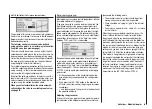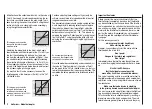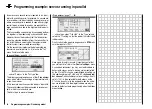
82
to the desired positions, using the appropriate transmit-
ter controls.
Press the
SELECT
button to store these positions as
the Fail-safe settings. They will now be transmitted to the
receiver’s memory at regular intervals, so that the recei-
ver can immediately call them up if interference should
strike.
The screen confi rms briefl y that the information has
been stored:
W A R N I N G
You may be tempted to switch the transmitter off
when you are fl ying a model in order to test your
fail-safe settings. Don’t do it! If you do, you run a se-
rious risk of losing the model, as you will be high-
ly unlikely to be able to re-activate the RF signal in
time, since the transmitter always responds with the
security query “RF signal on YES / NO” when swit-
ched on.
If you select SPCM transmission mode but have not
yet carried out the fail-safe programming, you will see
a warning message on the screen when you switch the
transmitter on. The message remains on-screen in the
basic display for a few seconds:
Programming
The “Fail-safe” function determines the behaviour of
the receiver when a problem occurs in the link between
the transmitter and the receiver. In SPCM transmission
mode the receiver outputs 1 … 8 can optionally …
1. maintain their current position (“hold mode”):
if interference occurs, all servos programmed to
“hold” remain continuously at the position correspon-
ding to the last valid signal, until the receiver picks up
another signal which it recognises as valid.
2. move to a freely selectable position (“Pos”) if interfe-
rence occurs.
Use the right-hand rocker button to select the desired
channel 1 to 8 (
) and press the
SELECT
button in or-
der to switch between “hold” (
)
and “position” (
) mode.
Select the
STO
fi eld on the screen at bottom right using
the right-hand rocker button, and then simultaneously
move the servos which you wish to set to position mode
Fail-Safe settings
Fail-safe in the “SPCM” transmission mode
This menu appears in the multi-function list only if you
have selected the SPCM transmission mode. This mode
of operation must be pre-set in the memory-specifi c
»
Base settings
« menu.
The SPCM transmission mode can be used with all re-
ceivers with “smc” in the type designation (smc-19, smc-
20, smc 19 DS, smc-20 DS etc.).
The operational security of Super Pulse Code Modula-
tion (PCM) is inherently higher than that of simple Pul-
se Position Modulation (PPM), since the receiver incor-
porates an integral micro-processor which is capable of
processing received signals even when they are “noisy”.
Only if the received signal is incorrect or garbled due to
outside interference does the receiver automatically re-
place the invalid signal with the last received correct sig-
nal, which is stored in the receiver. This procedure sup-
presses brief interference caused by local drops in fi eld
strength and similar momentary problems, which other-
wise result in the familiar “glitches”.
Caution:
If you are using the SPCM transmission mode, we
strongly recommend that you make use of its safe-
ty potential by programming the fail-safe throttle po-
sition of a glow-powered model to idle, or the thrott-
le position of an electric-powered model to “motor
stopped”. In this way you ensure that the model is
much less likely to cause havoc if subjected to inter-
ference; if this should occur on the ground, the mo-
del could otherwise cause serious personal injury or
damage to property.
Fail-safe
Summary of Contents for MX-16S
Page 1: ...1...
Page 17: ...17...
Page 31: ...31 Fixed wing models Installation and connections...
Page 35: ...35 Program description Reserving a new memory...
Page 47: ...47 Base settings Model helicopter...
Page 83: ...83 Fail safe...
Page 89: ...89 Programming examples Fixed wing model...
Page 109: ...109 Programming examples Model helicopter...
Page 112: ...112 112...
Page 116: ...116...
















































